- INTRODUCTION
- LECTURES
- A_Mart Kalm / Modernism In Estonia: From Industrialist’s Villa To Kolkhoz Centre
- B_David Crowley / The Fate of the Last Generation of Ultra-Modernist Buildings in Eastern Europe Under Communist Rule
- C_ Claes Caldenby / Urban Modernity. Nordic-Baltic Experiences
- D_Marija Drėmaitė And Vaidas Petrulis / Modernism In Soviet Lithuania: The Rise And Fall Of Utopia
- E_Anna Bronovitskaya / Glimpses Of Today In Visions Of Russian Avant-Garde Architects
- ESSAYS
- Ernestas Parulskis / Commemorative Plaques In Lazdynai
- Indrė Ruseckaitė and Lada Markejevaitė / Elena Nijolė Bučiūtė’s Personal Modernism
- Maija Rudovska / In The Shadows Of Nostalgia. Marta Staņa’s Legacy In Latvia
- Liina Jänes / Position Of The “Other”: The Architecture Of Valve Pormeister
- Julija Reklaitė / Amber Inclusions. What Modernist Memorabilia Can Tell Us
- INTERVIEWS
- Talking About the Richer Picture. An Interview with David Crowley by Aistė Galaunytė
- An Active Archive For A Public Discussion. An Interview with Hartmut Frank by Eglė Juocevičiūtė
- Cheating The Space Or Cheating The Time. An Interview with Frédéric Chaubin by Eglė Juocevičiūtė
- More Freedom, More Privacy. An Interview with Anna Bronovitskaya by Eglė Juocevičiūtė
- Sinchronicity of Ideas. An Interview with Andres Kurg by Eglė Juocevičiūtė
- Recycling Socialism. An Interview with Aet Ader by Viktorija Šiaulytė
- ABOUT
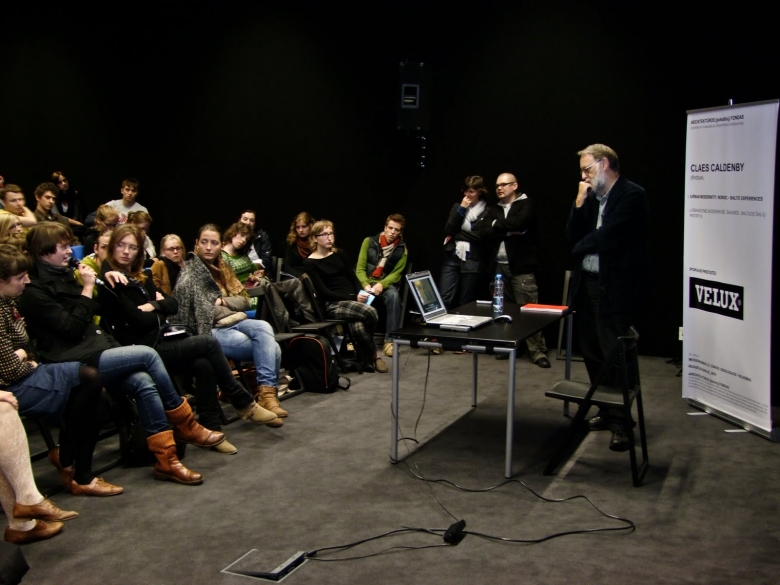
Claes Caldenby during the lecture. Photo: Norbert Tukaj
This lecture is based on a book which has just been recently published. We have a network of the Nordic and the Baltic do.co.mo.mo organizations, and do.co.mo.mo is an organization which is about the documentation and conservation of buildings, sites and neighbourhoods of the modern movement. It has about fifty member countries from all over the world. It has regular meetings of different working groups as well as a great assembly every second year. This year it was in Mexico City and the book was published on the occasion of that event. It is actually the third book that we have produced and our ambitions have been growing all the time. It is bigger, and I think, it is better, than the one we produced before. Nevertheless, there is so much more to do on this.
I would say that this is the first book which takes a very broad perspective of the Nordic and Baltic countries and describing the period of urbanism of the 1960s–1970s. The theme of the conference in Mexico City was “Living in the Urban Modernity”. We tried to expand that subject to talking about living and dying in the urban modernity in that living and dying means from “cradle to grave”. There are three aspects of this formulation in the book and they will also be present in my lecture.
The first aspect is that urban modernity, from the 60s and 70s, is about these very large estates or areas like housing estates, university campuses, industrial estates, central business districts, hospitals and cemeteries. They formed a sort of road “from cradle to grave”, from day nurseries and schools in housing estates all the way to the cemetery, which is the last station of this road – a time when society took care of its citizens “from cradle to grave” in a rational way.
There is also a second aspect to the “from cradle to grave” theme, which I will come back to at the end. This is a discussion about the modernism from its cradle to its supposed death in the 1970s.
And then we have the third “from cradle to grave” theme which is about sustainability. This has to be changed into a perspective of “from cradle to cradle” if we want to build a sustainable society.
I will start by going through these six types of areas that we chose for the presentations and in which we acquired examples from eight countries: the five Nordic and the three Baltic countries.
The idea of the functional city consisting of zones, or estates, or areas, is based on the modernist Athens charter made in 1933 and published in English in 1943. It has a large number of points, but the basic things come at the end. Point 76 is about the four keys to urban planning, which are the four functions of the city: dwelling, work, recreation and transportation. Point 78 emphasizes the importance of the utmost economy of time. You separate different functions and then you have to unite them by a traffic system that is rational and efficient. It is fundamental to modernist urbanism and the basis for development, especially in the postwar decades of the 60s and 70s.
I am a bit biased since my background and my fundamental knowledge is about Swedish architecture and planning, in particular 20th century architecture, which has been of great interest to me. However, I think it is viable to say that Sweden was leading this development in many ways in the postwar years. There was an idea of something called the “ABC town” in Stockholm in the early 1950s planning. The three letters ABC stand for workplace, housing and centre, which can be both commercial and cultural centres.
 An example is the planning by Sven Markelius (1945), the chief planner of Stockholm in 1950s. Here you can see a description of a new suburb or satellite city around Stockholm. The “I” is an industrial estate near the railway and metro station, the centre is close to the metro station. “H” stands for high-rise housing, and you can see there is a zone of the schools and sports facilities. Then you have the number of local centres “C”, “R” is terraced housing, and “V” stands for villas. The further you get from the station, metro or railroad, the lower the density of the housing.
An example is the planning by Sven Markelius (1945), the chief planner of Stockholm in 1950s. Here you can see a description of a new suburb or satellite city around Stockholm. The “I” is an industrial estate near the railway and metro station, the centre is close to the metro station. “H” stands for high-rise housing, and you can see there is a zone of the schools and sports facilities. Then you have the number of local centres “C”, “R” is terraced housing, and “V” stands for villas. The further you get from the station, metro or railroad, the lower the density of the housing.
The idea of the “ABC” was that these three aspects – work, housing and centre – should be together. But according to the idea of the functional city of the Athens charter, first you separate them, and then you have to unite them again – arrange a planning system which unites what you have already separated. So this can be described as a sort of tension in these planning ideas.
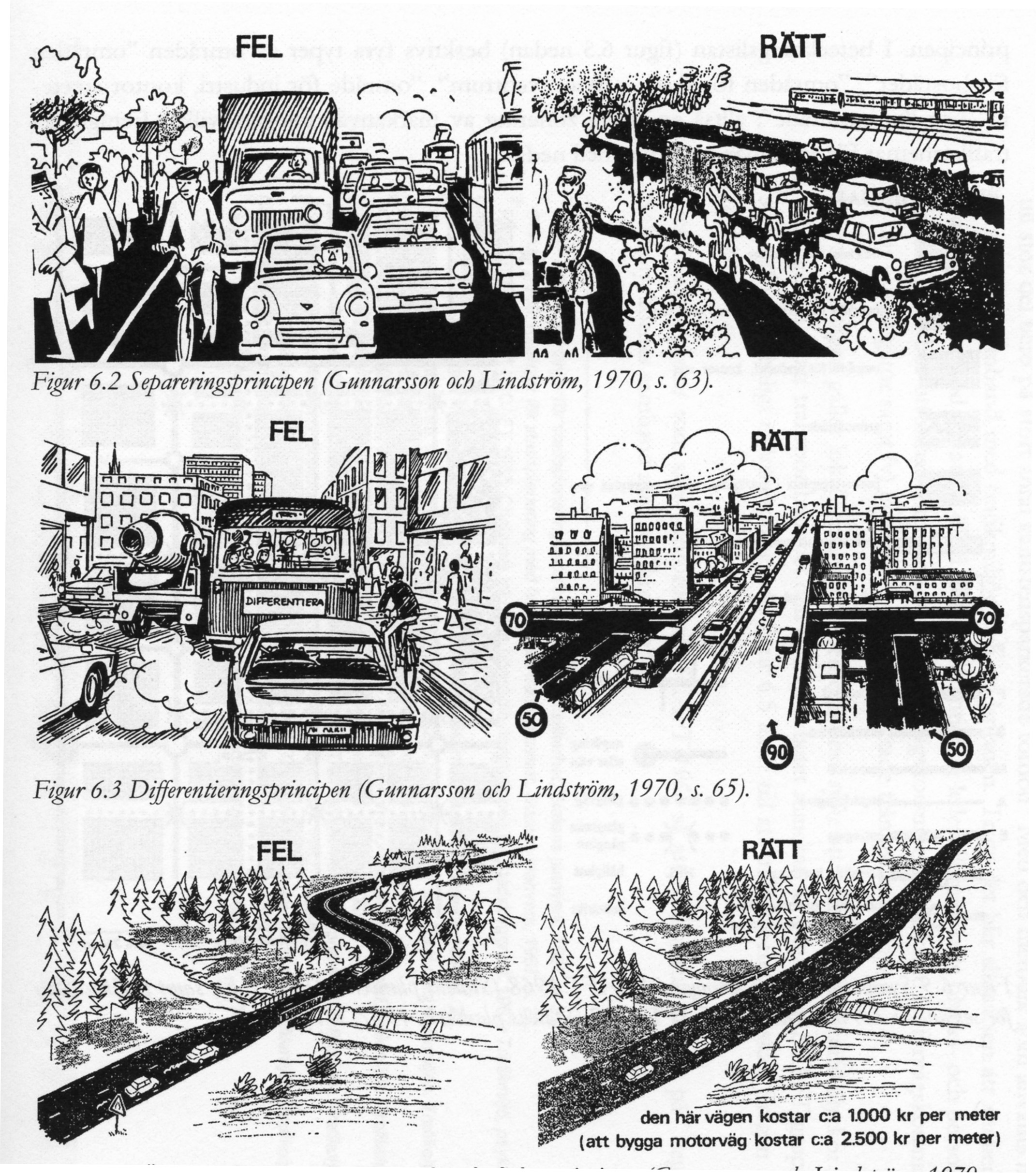 The Swedish planning ideas of the 1960s are very much about traffic planning, the need for efficiency in traffic planning, especially for rapid car transport. Principles of traffic planning according to a 1970 Swedish book showing two columns – one is “fel” which is “wrong” in Swedish and the other one is “rätt” which is “right”.
The Swedish planning ideas of the 1960s are very much about traffic planning, the need for efficiency in traffic planning, especially for rapid car transport. Principles of traffic planning according to a 1970 Swedish book showing two columns – one is “fel” which is “wrong” in Swedish and the other one is “rätt” which is “right”.
This is about the three aspects of traffic or road planning, the separation of different kinds of transports, pedestrians, and bicycles; differentiation of speeds or different streets, so you should have streets where the cars can drive 70km/h, and then when you get closer to the housing, you should have slower streets where you can drive 50km/h or 30km/h, a very hierarchical system. The school of architecture which I come from, Chalmers, developed this system (called SCAFT in Swedish) in the 1960s and it was used all over Sweden. You will find similar principles all around Scandinavia and also in the Baltic countries. Simplicity in this principle means that you should not make roads with big turns, straight roads are more efficient as a shorter way between two points. Of course, this idea of planning led to a city which was a kind of an archipelago of separated islands.
 The plan of Copenhagen from 1947 is famous as the so-called “Finger” plan, where green belts between the housing and these enclaves or islands of housing and other functions are typical. The diagram shows that they are separated points, based on rapid public transport with its stations. The same system was used for Stockholm, called a ‘pearl necklace’ structure of the city and was developed in the 50s and 60s.
The plan of Copenhagen from 1947 is famous as the so-called “Finger” plan, where green belts between the housing and these enclaves or islands of housing and other functions are typical. The diagram shows that they are separated points, based on rapid public transport with its stations. The same system was used for Stockholm, called a ‘pearl necklace’ structure of the city and was developed in the 50s and 60s.
Looking at ‘the cradles’ – the housing areas – you will find a number of characteristics. The interesting aspect of the work in this book is that we have the material to initiate a comparison of the different countries. For example, a consequence of this traffic planning system is that essential parts of these housing estates will consist of pedestrian streets or maybe bicycle streets. Obviously it was possible in Helsinki at that time and you also had the prefabrication system, which is typical to both Sweden, and Finland.
Another aspect, which is typical of this period of planning, is the relation between the building system, or the construction system and the site or the situation where you build. I will come back to it because it is a very typical area in many ways.
 Shopping centre in Hammarkullen in the early 1970s. Photo: Gothenburg city archive
Shopping centre in Hammarkullen in the early 1970s. Photo: Gothenburg city archive
In the area from around 1970, called Hammarkullen in Gothenburg, is an underground tram station. Very large straight 8 storey houses are in the centre. On the outskirts there are terraced housing of different kinds. These have a different structure, which can be more adapted to the site. Gothenburg is a very hilly city; there is the problem of adjusting to the site all the time in different ways. It was the so-called “Million” programme in Sweden, where we built one million flats in ten years from 1965 to 1974. They started by making the ground completely flat, because it is much easier to build prefabricated buildings on flat ground. If there is something wrong with the ground, you have to change it because it is the construction system that is more important. Tallinn does not have the problem of a hilly landscape, but at the same time some of these 1970 areas were very geometrical, which is typical for this period. It is quite fascinating to take the extremes of the Nordic and Baltic region, so that you can see how these new housing areas were built in Reykjavik in Iceland, for example. Of course, you know of Lazdynai in Lithuania, which is a different scale altogether, but the structure of the area is quite similar in many ways.
If we go to the next step on this road of “from cradle to grave”, to university campuses – these were in many ways typical building tasks for the period of the 1960s and 70s. An expanding number of students, expanding research, and a higher percentage of people going to university studies created a need to build a lot of university buildings very fast. There was also an expectation that this growth of universities would continue, which meant that the university campus had to be surrounded by open ground to be able to expand. It also meant that it had to be outside the city and even have a sort of free landscape between itself and the city. The importance of the expansion over time was emphasized; a very flexible structure, which was situated in an open space was needed, an example of which is the Frescati university in Stockholm.
 The university in Oulu in Finland (from the early 1970s) is very similar; it is a very dense structure built in the forest, 2009
The university in Oulu in Finland (from the early 1970s) is very similar; it is a very dense structure built in the forest, 2009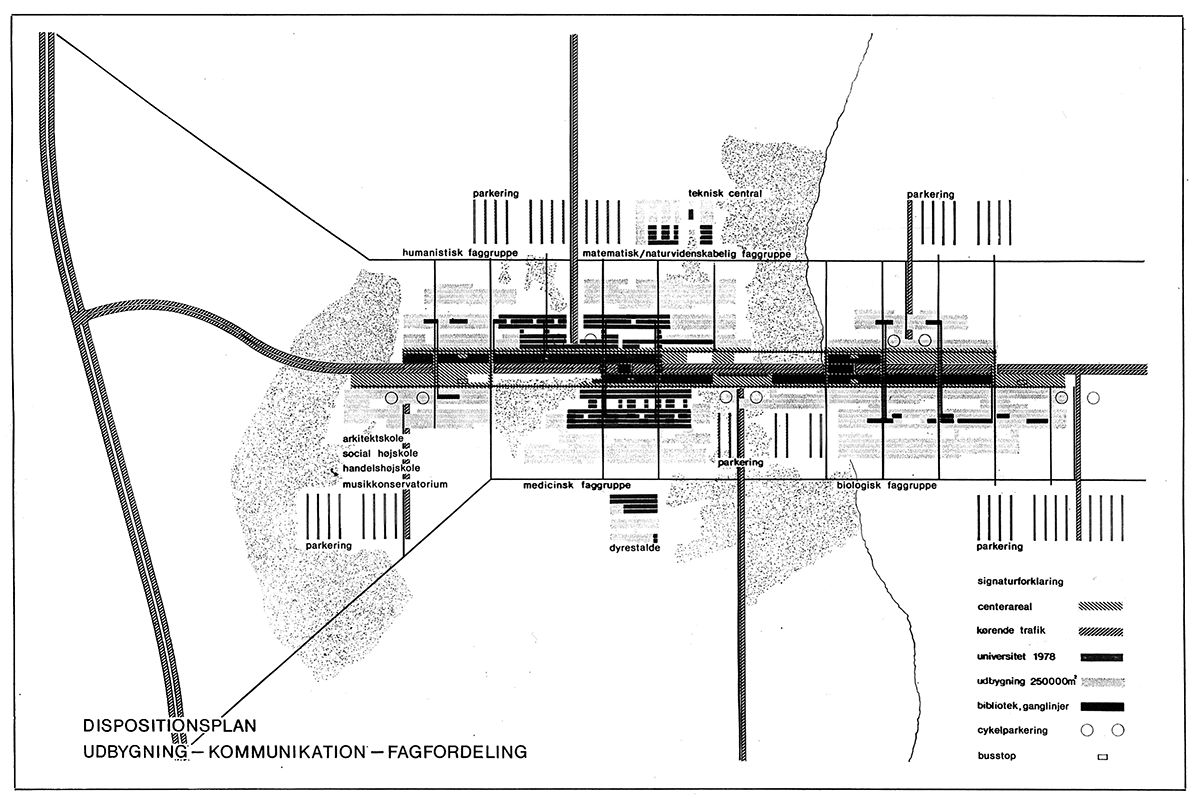 The same idea of expansion and flexibility is characteristic of Odense University, one of the most typical 1970s universities. The structure is on open land outside the city, where it could grow along its axis to at least twice its size. There is an axis and the possibility to grow along and to the sides of that axis.
The same idea of expansion and flexibility is characteristic of Odense University, one of the most typical 1970s universities. The structure is on open land outside the city, where it could grow along its axis to at least twice its size. There is an axis and the possibility to grow along and to the sides of that axis.
The third step on this road is the industrial estates. One of its features is that even if you build an industrial town, like Elektrėnai in Lithuania, where housing and industry should work together, you tend to separate the two of them. Industry is on its own and the housing is also set apart and there are quite large spaces around the houses through which you have to walk.
 Morning in Elektrenai, early 1980s. Photo: Elektrenai plant archive
Morning in Elektrenai, early 1980s. Photo: Elektrenai plant archive
The city of Gothenburg, which I come from, is famous for its car industry. It started in Gothenburg in the 1920s. Initially, there was an industry of roller bearings in the city that had a name for the product Volvo, which means “I am rolling”. There were some engineers who thought that roller bearings could be used for cars, so they started producing cars and then it became an industry on its own. In the 1960s they moved to a new huge site, quite distant from the city as the car industry tends to do.
 Volvo Torslanda car plant, air view
Volvo Torslanda car plant, air view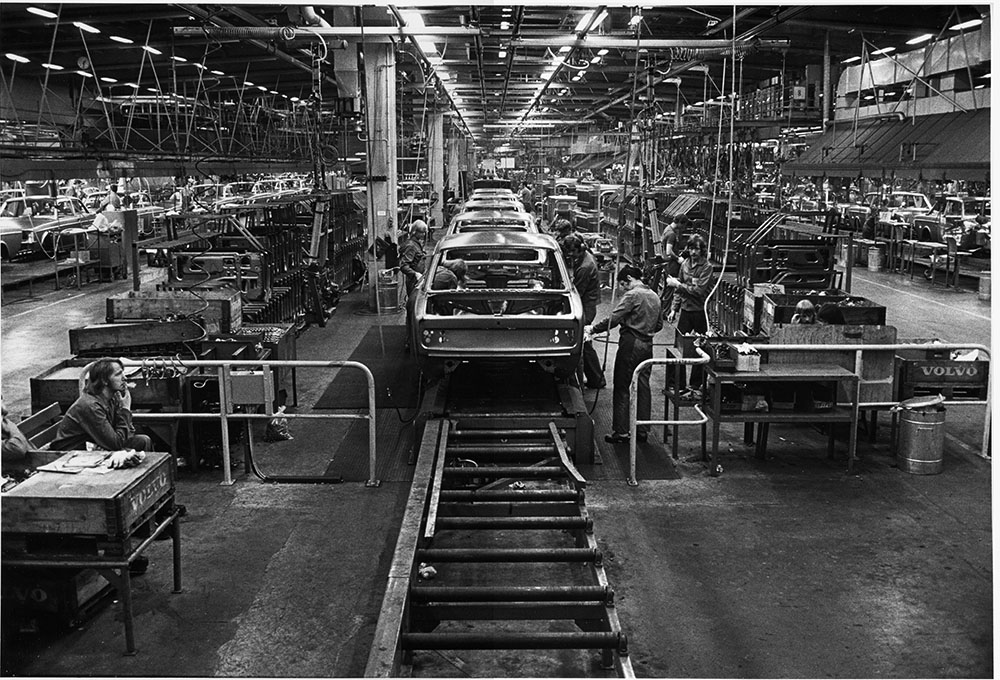
One needs to mention that this industry was situated outside the city, but it demanded a lot of planning for such things as a new bridge and new housing areas with efficient transport to this car factory. The car plant is quite important for the economy of the city and has turned it into a planning task for the city to see that the car factory was connected with the sort of transportation infrastructure it needs in order to function efficiently.
The fourth aspect of this road “from cradle to grave” is the central business districts. The CBD was a part of modernist urbanism, a case of building in the central parts of the city. However, according to modern planning principles, you had to demolish all the buildings in the centre of the city and build a new modern urban structure instead. One of the most famous examples is Stockholm city plan. You can see on the map all the demolitions of older blocks that took place from the early 1950s till the late 1970s. They were replaced by new structures, in which the five high rise buildings are especially famous. They were a sort of sign – it was an early modernist idea from a project in the academy of architecture of the late 1920s to have these high rise buildings as a sign of the modern city. These high rise buildings are placed on a lower two-storey structure, which was typical for the American high rise buildings in the years after the war. But these were planned in the late 1940s at about the same time as the Lever House and other buildings in New York. Then there is a circulation place for cars in the centre. The pattern with the triangles in black and white is a square for pedestrians, walking under a super-ellipse, which was a new shape invented by a Danish physicist and poet Piet Hein.
It has to be remarked that this is a very interesting symbol of modern urbanism. The centre of the capital of Sweden is a traffic circulation place where the pedestrians are underground. It is a sort of essence of modernist urbanism. The high rise buildings were finished in the early 1960s and during the 1960s there was quite a strong critique against this new centre of Stockholm, which was only offices and shops and no culture, no history, no memory of the old city. So, Kulturhuset which is now the cultural centre of Stockholm, built around 1970, was a response to that critique.
Stockholm city centre was an archetype of modernist urbanism; Stockholm has also been described in international books as ‘the planned city’. To be able to complete or to afford a wholesale reconstruction of such a large area in the centre is exceptional and was an inspiration to other countries; however, it was actually difficult to achieve the same results.
 “Brivibas iela”, at that time called “Lenina iela” in the centre of Riga was an urban renewal project which had the ambition of doing something similar to that of Stockholm, but could only build single buildings, not such a wholesale reconstruction of the old area as had been in Stockholm. Visualization by Ivars Strautmanis, 1961
“Brivibas iela”, at that time called “Lenina iela” in the centre of Riga was an urban renewal project which had the ambition of doing something similar to that of Stockholm, but could only build single buildings, not such a wholesale reconstruction of the old area as had been in Stockholm. Visualization by Ivars Strautmanis, 1961
Experimental project for Tallinn of 1968 by architects Mart Port and Male Meelak was not realized at all
The fifth type of estates is hospitals, which typically are very scientifically based. They are very much about concentration in this period and it was supposedly more efficient to have concentrated structures, where walkways for the staff are as short as possible. Again, flexibility was very important, because of the ways of medical treatment were changing all the time. Hospitals have to be flexible and have the possibility to change during the run of time even more than universities.
 The new Huddinge University Hospital which was finished in the early 1970s was almost as big as the old medieval centre of Stockholm, as a popular montage of the 1960s shows.
The new Huddinge University Hospital which was finished in the early 1970s was almost as big as the old medieval centre of Stockholm, as a popular montage of the 1960s shows.
The hospital in the south of central Stockholm is very compact and there are some interior light wells or courtyards in these structures, but it is very typical for the period. It has a sort of concrete façade which has a sculptural pattern to make it more easily acceptable. You could find this feature in a number of similar structures, because size was seen as a very positive sign of an expansive and very modern period.
The last station on the road through modern urbanity takes us to the cemeteries.
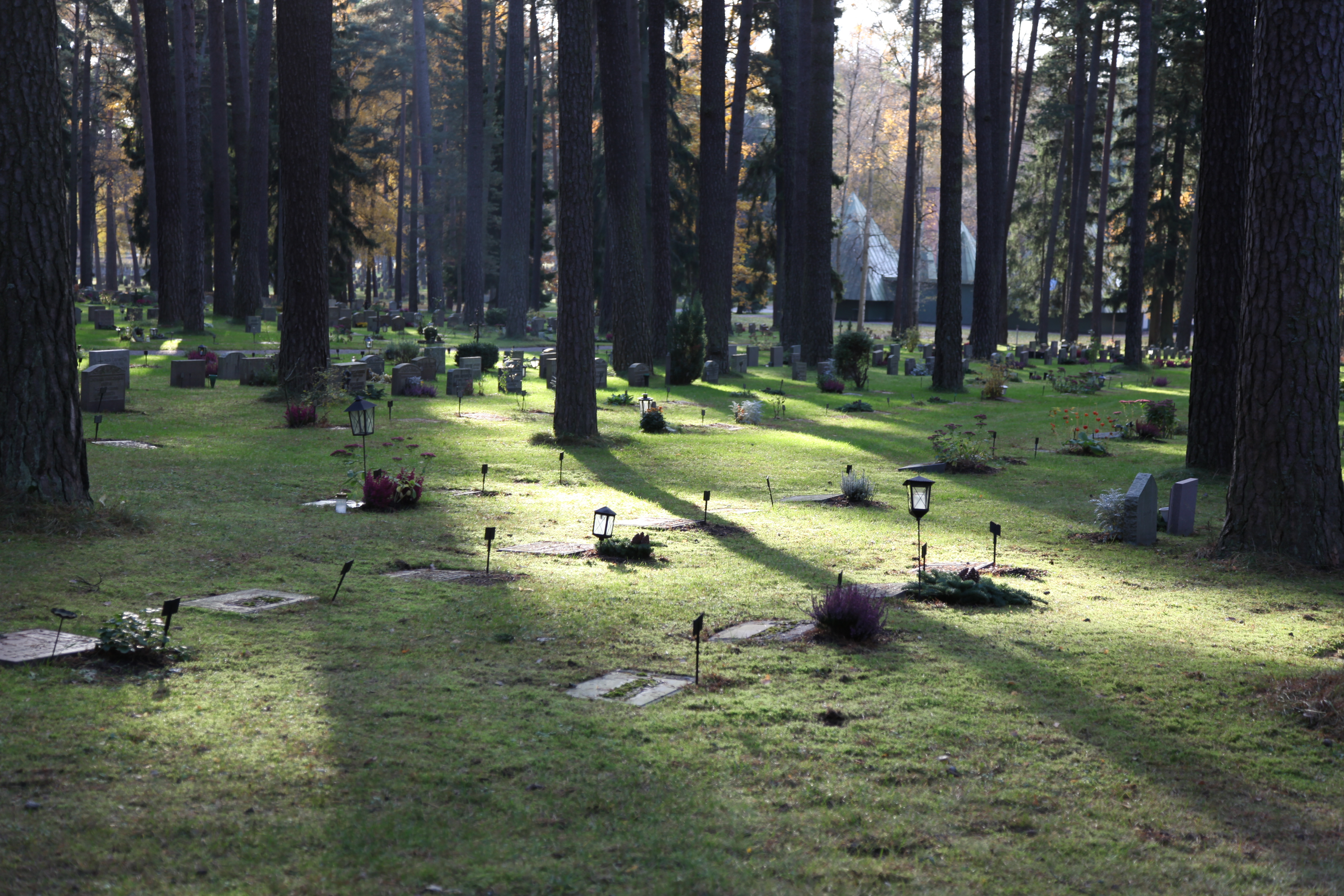 A classical example is The Woodland Cemetery (Skogskyrkogården) in Stockholm. It was designed following a competition in 1915, which was won by the architects Gunnar Asplund and Sigurd Lewerentz. The last chapel was finished in 1940. Photo: Claes Caldenby
A classical example is The Woodland Cemetery (Skogskyrkogården) in Stockholm. It was designed following a competition in 1915, which was won by the architects Gunnar Asplund and Sigurd Lewerentz. The last chapel was finished in 1940. Photo: Claes Caldenby
Gunnar Asplund was one of the first to be buried in the building he had designed himself. This place is typical for the type of forest cemetery, landscape cemetery or woodland cemetery, an idea which had come from Germany. The woodland cemetery in Munich is one of the first examples and this was a model for Stockholm, where the graves are placed very freely in the forest between the trees. These cemeteries are often called a “haven of beauty”, as a refuge, a place in another world which is uncommon to us.
Actually the name “a haven of beauty” was not used for cemeteries in Sweden, but it was used for the churches built in the late 1950s and through the 1960s and 70s. In this context a haven of beauty meant that the rest of the architecture was not about beauty, it was about rationality and efficiency. Churches became one of the few tasks in Swedish architecture in the 1960s, where architects had artistic freedom, which was very unexpected, because modernism in the 1930s was manifestly uninterested in church buildings. With all the new suburbs built in Sweden in the 1950s and 1960s, each of them had to have its own church. This is quite unexpectedly one of the extensive periods of church construction in Sweden. These churches were designed by a number of architects who worked in a sector beside this rational large scale production of architecture, typical for the rest of the work. One could say that these landscape cemeteries are really a Scandinavian contribution to the international modern architecture. At least this is the idea of the architecture historian Mark Treib from California who has written about landscape architecture and cemeteries. He believes that these landscape cemeteries are exceptional and you will find few examples outside of Scandinavia, or that they appeared earlier in Scandinavia. We have the situation in Oslo, which is also quite a hilly town, where the landscape can be used for this free planning of landscape cemetery; or in Copenhagen, which is much flatter – there you have more ideas about the strict geometry, but also the relation between the strict geometry and free or wild growth of the green area in a cemetery.
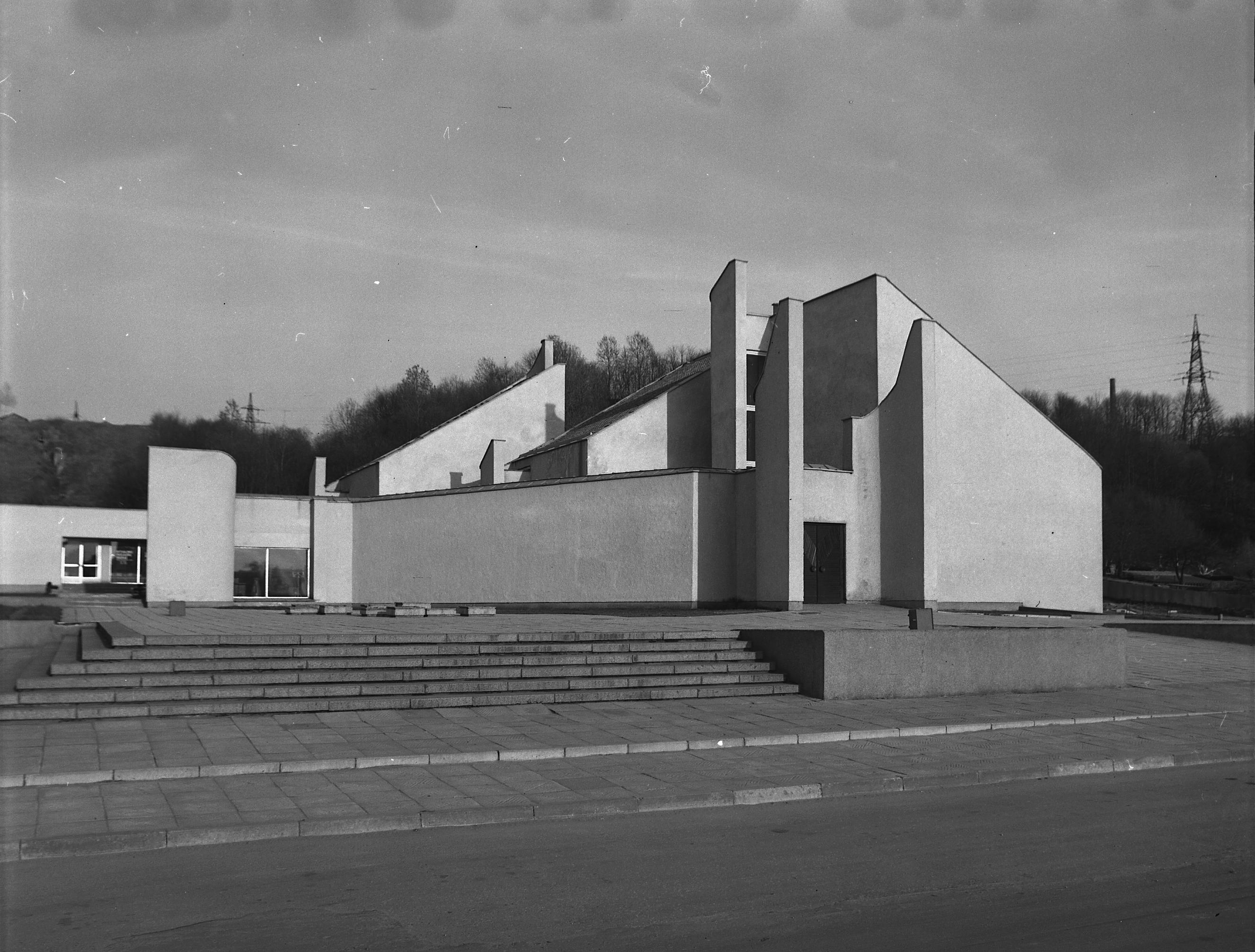 Funeral home in Kaunas. Photo: Romualdas Požerskis, 1985
Funeral home in Kaunas. Photo: Romualdas Požerskis, 1985
Also of interest is Kaunas funeral home in Lithuania, which is one of the examples in the book. It raises a very interesting question: what is the function of churches or cemeteries, in particular in a modern society? They are sites of memory in a way; but the question is whether this site of memory of the deceased people, of your relatives, is a private matter, or is it a general, existential site of memory, to go out into nature and be reminded of some profoundly existential aspect of life? I was very fascinated by the story of what happened in some of the cemeteries in Vilnius in the 1950s, where students went there in early November, on All Saints’ Day. That was enough of a reason to be expelled from university, because you were not supposed to have that kind of memory. In such cases memory is not private, it is much more a public matter. This difference would be very interesting to look into more thoroughly and to understand better what it actually means.
So, that was a tour through modern urbanity. This is a small part of the material we have collected in this book. I would just like to give you one or two more examples. There are more shopping centres which are called “ABC 1”, “ABC 2”, “ABC 3” and 4 and so on in Mustamäe, one of these 1970s areas in Tallinn. “ABC”, as you might remember, is the town planning principle of Stockholm in the early 1950s. So it was taken directly from Stockholm at that time. It really does not have anything to do with the idea of “ABC” as it was thought about in Stockholm. But it obviously had some importance and it was an inspiration. Architects from the Baltic republics went to Vällingby in Stockholm, for example, which was inaugurated in the mid-fifties, and that was a very important model of these “ABC” city ideas in Stockholm. It would be interesting to understand how these contacts were made.
The other case is the poultry farm outside Tallinn in Estonia. This shows something which you did not find in Sweden, for example this being a sort of modernist urbanism in agriculture. Agriculture was considered by this time in the 1950s to be something far behind and something we were about to leave. There was practically no idea in Sweden about developing modernist urbanism in agriculture. This difference would also be interesting to look closer into.
I think you could argue that Sweden was quite early with its development of modernist urbanism in the postwar decades and also quite efficient because it was a relatively rich country or became so through the 50s and 60s and could afford such projects like the Stockholm City Centre. The interesting aspect is that as much as Sweden was leading the development of modernist urbanism, it was also possibly leading the criticism against it. There is a connection between that: if you have successful modernism, meaning that very much was changed; it also causes a reaction, a critique against it.
One example which is, more or less, official, is an exhibition put on by the Swedish Museum of Architecture, a state institution, in the mid-1970s. This was also produced in a German version and toured in Germany in 1976. There was also a catalogue about the breaking up and crisis of functionalism or modernism. Germany was still obviously not ready to receive that message in 1976. The German authorities, who had received this exhibition and showed it to the public, understood it as quite a strange argumentation.
 A spread in the end of the catalogue Aufbruch und Krise des Funktionalismus. Photo: Jens Jensen
A spread in the end of the catalogue Aufbruch und Krise des Funktionalismus. Photo: Jens Jensen
One spread of the catalogue, which is an interview with some architects shows the photo from Hammarkullen area in Gothenburg. The interview in the catalogue says - we tried our best, but we could not carry out our thoughts and goals; and the clients and the builders did not want to listen to the architects. Whatever we said, they said not to mess things up. Make it simple, make it big, make it fast. That is the only thing that is important.
 Picture from a 1974 book Hammarkullen by Jens Jensen
Picture from a 1974 book Hammarkullen by Jens Jensen
It is also interesting to see the photo of a small boy in front of the very large houses, and there is another version, by the same photographer, who was actually educated as an architect at the school of architecture in Gothenburg. He was one of the 1968 students; you probably understand what that means when I say I was one of those too. He decided that he did not want to become an architect, because it did not seem to be a very nice profession for him. He became a writer and a photographer instead. His first book in 1974 was about the Hammarkullen area in Gothenburg with the photos of small children, who had been left alone in this very large and unfriendly area. Typically it is November and it is quite dark and rainy, like it is quite often in November in Gothenburg. It is not very sunny in his photos, if you understand what I mean. He interviews people there and they tell him about their lives and what they think of this area. It was characteristic of this period to do these kinds of reports ‘from reality’, so to speak. It is also very interesting that he came back some ten or fifteen years later and actually published three books on this area where he interviewed some of the same people that he was able find again. Following the lives of these people, what had happened to them when they grew up in this area; he managed to find them even when they lived in other places.
He also made another book typical for that time. He worked for some time at the Volvo car factory, so the photo of the Volvo car factory I showed was also taken by Jens Jensen. It was also customary for the period that you took that kind of a job as an academic to know about reality. He made a book containing interviews with people working there and the title of the book is “They call us car builders”. It was sort of nice. You should have a professional pride if you are a car builder, you know. You build something important, but the expression “they call us” means that this is not the truth. It is something those ‘up there’ say.
Universities were of course a target for this criticism from the 1968 students and a student at the Frescati University in Stockholm made a number of collages around 1970.
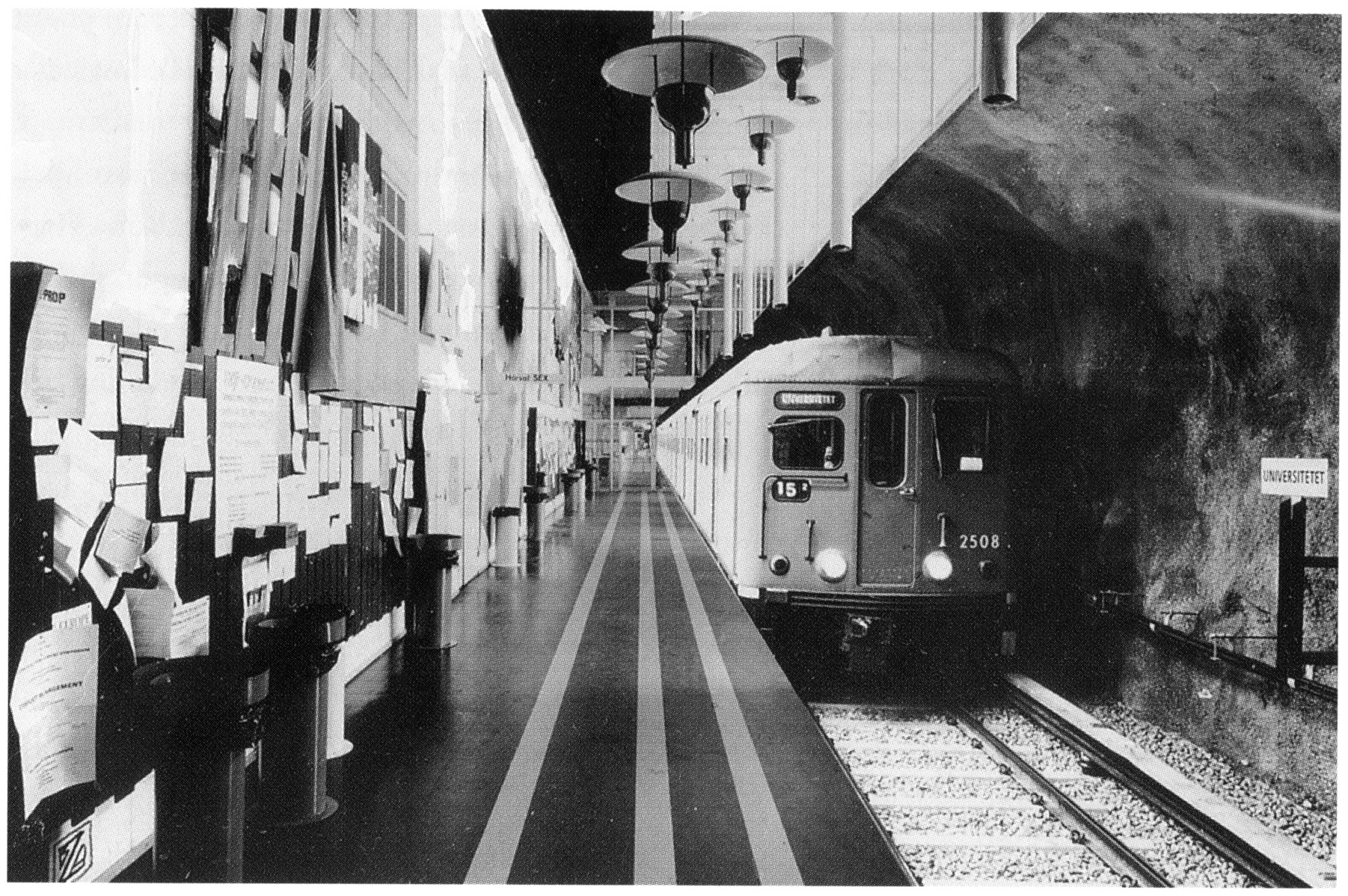 Collage “We let the trains pass the auditoriums. Fastest possible throughput. Like on a track” by Bo Zachrisson shows the main corridor of the university building built in 1970 put together with the metro line actually going there. The thought behind it is that the idea of this university is a throughput as fast as possible, like on a track. Then you should be an efficient and working member of society.
Collage “We let the trains pass the auditoriums. Fastest possible throughput. Like on a track” by Bo Zachrisson shows the main corridor of the university building built in 1970 put together with the metro line actually going there. The thought behind it is that the idea of this university is a throughput as fast as possible, like on a track. Then you should be an efficient and working member of society.
I am very curious whether there was some similar criticism here in Lithuania during this period. There was in Estonia, it is also mentioned in the book here. It consisted of a group of architects and artists, sometimes called the “Tallinn 10”.
Leonhard Lapin “City for the living and city for the dead”, 1978
It is a sort of fantasy about what would happen if you made a cemetery in one of these 1970’s prefabricated housing areas. It is full of different references to his friends and you see he even buried himself there. It is very modernist, a kind of Soviet constructivist sculpture. One of the members of this group was lucky enough to be able to buy a Lada at that time and he is depicted being buried in his car in the parking garage under the courtyard. You can make a lot of interesting interpretations of this image.
When we were producing this book, I looked for similar examples of criticism, but so far it seems this criticism has been much more present in Sweden than in most of the other countries, which is again interesting to understand why. I grew up with that criticism. We as students started to give ‘demolition prizes’ to new buildings in the late 1960s, which we thought should be immediately demolished since they were so bad. This was really typical for our generation and I would be surprised if that was not the case in other countries too. I would like to emphasize that when I talk about criticism towards urban modernity, it must be understood that self-criticism is actually the fundament of modernism.
If we look at the situation in Sweden now, for example, 25% of the building stock was built during this “Million Programme”. That means it was built between 1965 and 1974. It means that if we want to develop a sustainable city, we have to do it with the material we have. It is very difficult to imagine doing the same as the modernists did in the 1960s – to tear it all down and replace it with something better, to replace the old mistakes with new ones, as was said in a cartoon by one of the architects of the 1960s.
The concept of “from cradle to cradle” was coined by William McDonough and Michael Braungart in what they called “The Hannover Principles” in 1992. They have around ten points as a sort of manifesto of principles. One of them is recognized interdependence and another – the eliminated concept of waste. You have to understand the city as something that consists of interdependent parts, which have to be joined somehow. At the same time, if you want to follow this principle to eliminate the concept of waste – tearing down most of these areas is not an option, I think. We have to treat them differently. The question we are facing and the question that the students are facing to a very large extent today is how to turn the urban modernity around.
 Turning the perspective upside down in Hammarkullen. Photo: Trad Wrigglesworth
Turning the perspective upside down in Hammarkullen. Photo: Trad Wrigglesworth
There is a very strong hip-hop culture now in Hammarkullen, they have a group called “Hammer hill” who are very international. They come from all over of the world because this area is typically an area with a very high percentage of immigrants in Sweden. They also have, for example, a carnival because a lot of people came from Chile after the military coup in Chile in the mid-1970s. They came to Sweden and they happened to live in this area so they started this tradition of a carnival. I’ve already talked about the three books concerning this area and there is also a number of TV series about it. It is perceived as the archetypical 1960s or “Million Programme” suburb of Sweden. When a new Centre for sustainable urban development in Sweden began recently, there was a competition between three cities to get it and Gothenburg was happy enough to be successful, a big ten year project, called “Urban Futures”. It is a joint effort between Chalmers University of Technology, the School of Architecture, the municipality of the region and different private parties who have taken part in this development. One of the pilot projects they are developing, which started a few months ago, is to develop the Hammarkullen area in different ways.
For example, one way of doing it is to support development that has already been started slowly - to have university departments in this area. Because the idea is that people living here, which to a large extent are immigrants, have a network around the world which is very important for Swedish culture. We recently had elections and a right-wing extremist party was elected to parliament for the first time, which I find very sad. It makes it even more necessary to develop these ideas of the richness and possibilities of these areas where there are a lot of immigrants in Sweden.
There are many efforts and we have already had student programmes doing that – to find ideas of how to develop the sustainable city out of the existing structure. It is not an easy task. One of the most difficult problems is this very hierarchical structure of separated areas, which I have been describing here, it is usually mono-functional. To break that system without destroying what already exists is an enormous challenge.
I also think that the sort of work we have started here, which I hope we can continue, could continue in this way. This question about urban modernity in the 1960s and 70s is not a question of the history of architecture only. For me architectural history is always here and now and is always influential on how we continue to build our cities. That is my message tonight. Thank you.
Tomas Grunskis (T. G.): Thank you very much. The discussion after the lecture is as important as the lecture itself. So we would like to ask you some questions. Modernistic architecture and the cultural movement have had a very interesting, almost conflicting situation with history. Now it is becoming history itself and this conflict seems to have disappeared. We had this journey from cradle to grave, but I was thinking to myself – is this modernism already dead? A few generations of architects were brought up with the ideas of modernism after the 1960s and 1970s. It seems to me, after postmodernism, in some cases I see some renewed ideas of modernism in contemporary architecture. Or am I wrong perhaps?
Claes Caldenby (C. C.): I think this is a very interesting question; we could have another lecture about it. It is quite complicated but you were obviously right saying that modernism was not very interested in history in many ways. We know about an architectural history turn in the 1970s and I am part of that development too. There was an enormous surge of interest in architectural history in architecture schools. For example, the first Venice biennale in 1980 had the theme of “The Presence of the Past”. Practicing architects were interested in history. There was a development from 15 museums of architecture to 90 museums of architecture during the 1970s and 1980s. We had, of course, neo-modernism in the 1990s, but that is also, to my mind, quite superficial, it is an aesthetic of modernism. The important parts of modernism were made into an aesthetic for many architects, though what I have been talking about here is modernist urbanity and its many problems. We should not repeat these mistakes; this is one of my arguments, but at the same time, the debate that postmodernism is actually just a kind of subculture of modernism – from my point of view, we are still living in the modernist or modern period, but today modernism must mean something different than in the 1970’s. Also, we are living in the structures which were built at that time and we have to relate to it. One reason to understand why it looks the way it does is in order to be able to treat it. Diagnosis before treatment is a classic way of discussing these things.
T. G.: I have another question. It is very interesting that modernism as an ideology and cultural movement somehow unites two different political and economic systems – Western and Scandinavian with the Eastern and Soviet. These systems produced a lot of similar examples of urban modernity and modern architecture. Could you possibly describe the differences as you see them?
C. C.: What I have shown tonight, all examples from Scandinavia and from the Baltic republics means that you have similar urbanism in other parts. The reason for having the theme of the conference in Mexico City is that it is a global problem. I must make a short biographical note here because I was working on a dissertation in the mid-1970s which was on 1920s architectural theory in the Soviet Union and I was lucky enough to be able to meet the last surviving people from the 1920s generation. I interviewed Konstantin Melnikov in his own home in 1973, the year before he died, which is something I will always remember because it was such a feeling of what we call ‘the wings of history’ waving somewhere in there. I didn’t go to the Baltic countries at that time, but I did travel in other parts of the Soviet Union and I read the architectural magazines. I saw that the areas I showed tonight were considered to be front line projects in the Soviet Union at that time, something looked upon as a model. I got to know a librarian at an institute in Moscow and his great dream was to move to one of the Baltic republics after he retired, because that was closest to freedom. So, there was a difference between the different republics in the Soviet Union, but I think this is also the subject of another lecture or a number of lectures. There is so much to say about these differences.
I mentioned something about the inspiration from the West in the Khrushchev era: that it was possible to travel to Finland, Sweden or Denmark to see examples of that architecture at that time, which was very influential as far as I understand it. But at the same time, there are differences like the agricultural settlement which would not have happened in Sweden at the time. Another subject for collaboration I think.
Andrė Baldišiūtė (A. B.): I would like to know your personal opinion on where modern urbanism failed – in the form or the volume, the space or the content, that mono-functionality or misunderstanding of human behaviour. Maybe you see some other aspects?
C. C.: I think the main mistake was the misunderstanding that a city is not simply an addition of buildings; it is a structure on another level of complexity. If you read early criticism in the 1960s, Jane Jacobs’ book on American cities describes this problem with the organized complexity, which the city is and which was not understood by the city planners. I do not think the problem is in the form of singular buildings at all. We have examples in Gothenburg where the same prefabricated buildings were built in the centre of the city and they are very popular, a kind of middle class area with quite high quality. The problem is definitely not in the apartment plans because they are very good, I think the main problem is the urban structures, the lack of understanding of how the city works. It was simplified too much in a hurry. This idea of the functional city with four different functions is actually crazy, it is not only too simple, as manifestos always have to be simple, it is wrong.
A. B.: Do you think that this was one of the first times when the city was designed and it did not develop itself?
C. C.: I think the city has always been designed, there is no such thing as a city developing itself. It is not a natural phenomenon, medieval cities were designed but not in the way we understand it.
A. B.: In such a short time?
C. C.: Maybe not in such a short time, but there are examples of a very rapid building of cities according to traditional principles and which worked quite well in many ways. Now I’m almost arguing like the New Urbanism people, who are protecting the traditional urban grid cities. I think there was a problem in the rapidity they had in this period. Actually Sweden had one of the lowest housing standards in Europe in the 1940s just after World War II. It is easily forgotten because twenty-five years later Sweden had one of the highest housing standards. So, we were building enormously during this period in a great hurry and with way too little time to think about this complex question of what the city is.
M. G.: I studied sustainable urban design programme at Lund University for a semester and I got to know about one industrial area in Malmö which is now in the centre because of the growth of the city, and how it was being changed at the time. The municipality made a plan, which is really well thought through, how to bring it to the human scale and according to all sustainability principles. I would like to ask if you also had many living areas, with not really good qualities and if you changed them also and in which ways?
C. C: Do you mean the areas from the 1960s or 70s?
M. G.: Yes.
C. C.: About these industrial areas in the centres of the city: some of them became universities in the 1990s. Typically, industries move out to the outskirts of the city or maybe to another city or another country. If you look at the universities started in the 1970s, I think something like 15 or 20 new universities opened, small universities in small cities. All of them except one were outside the cities in these sorts of external locations. Then we had another boom of new universities in the 1990s and all of them were inside the city in the sense that they were built in existing areas, military or industrial areas in a number of cities. This shows the change of view on these questions which we are discussing here, where the students of universities are seen as something positive to the city, the city is important also for the university and they have a common interest in that. As for what is happening to these 1960s and 1970s areas, I would not say that many of them are in a bad state actually, there are a lot of technical problems for heating and insulation, but they are being looked after quite well, especially by these municipal companies as the owners of these areas. A number of them have been renovated with large amounts of money, but sometimes maybe not used in the most efficient or best way. The problem still remains: the structure of this part of the city, because that is very difficult to do something to, and this is a very fundamental problem.
M. G.: Have you tried to change the problems of modernism like mono-functionality or the need for human scale in those areas?
C. C.: There is a discussion about this, but again it is a very difficult problem and loss of human scale is also a very complicated question. For example, to what extent it is an architectural problem and to what extent it has to do with other qualities in the area. When we talk about sustainability, here it is clearly very much about social sustainability, not about ecological sustainability. It also has to do with the transport system, heating insulation and all other typical questions about the buildings. But it is fundamental that they are working socially in a good way. Because if you have big social problems, it would be very difficult to do the other things, so you have to develop things like, for example, starting university departments. It is one way of raising the status of the area, maybe taking care of parts of the population that want to develop and listen. I think a lot of things are happening and the problems are enormous and we have to work in different ways of doing this and we have to have an international collaboration of ideas and projects. We have collaborations already with people around Europe with different ideas of how to treat these problems, this is one of the main problems which architects are facing and will be facing in the coming decades. It will be the problem which you will be facing as architects as well.
Julija Reklaitė: I have the right to ask the last question and I am going to replace it with a wish that the next issue of do.co.mo.mo would be about dying and reviving in the urban modernity or dying and resurrecting.
C. C.: From cradle to cradle.
Straipsnis PDF formatu:
http://leidiniu.archfondas.lt/sites/default/files/41-52_lecture_claes%20caldenby.pdf




